STAMPS - THE REPUBLIC
The 1d, 6d and 1s. stamps of 1868 were followed in 1878 by a 4d for a letter rate reduction and a 5s. high denomination primarily for postage on packets of diamonds being sent to the Cape from the diamond fields.
In 1883/4 further postal rate reductions saw the introduction of the halfpenny stamp, the 3d and then the 2d to complete the set of eight values.
Another printing of the 1d value in 1894 had the colour changed to purple from brown, and in 1897 the halfpenny, 6d and 1s. were reprinted with colours yellow/orange, blue and brown respectively. However the 6d blue was not issued for postage without an overprint. In 1898 it was overprinted with the letter "TF" for telegraph use and in 1900 it was given the V.R.I. overprint when it became available for postage under British occupation. Copies of the unused stamp without an overprint are well known.
| |
|
|
|
|
| |
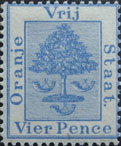 |
|
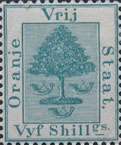 |
|
| |
|
|
|
|
Because the stamps were printed in London months elapsed between the date of ordering new stocks and their arrival in the Free State. Consequently provision had to be made in the meantime and this was achieved with the overprinting of surplus stocks of other values with the values needed. Local printers in Bloemfontein were used but, although their standard of work was high, there were many occasions when accidentally stamps were given either an inverted print, a double print or parts of the printing were defective in one way or another. The resulting varieties provide much of the fascination for study seen by collectors of this country.
1877. The first surcharge "4" on the 6d rose for a letter rate reduction.
1881. A shortage of one penny stamps but a surplus of the five shillings. Six different types of "1".
1882. Paper rate reduced to a halfpenny, but no halfpenny stamps - again the five shillings used.
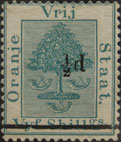
1882. Letter rate reduced to 3d. Obsolete 4d's used with five types of "3" two types of "d".
1883. Another letter rate reduction. The now obsolete 3d stamp was surcharged with "2d". Most 2's were narrow, but 1 in 6 was wider. Also one in the setting (probably of 240) was slightly smaller and had a distinct curly tail.
1890. One penny stamps again in short supply. The 3d and 4d stamps were used and four types of numeral are identified.
1892. Letters to the U.K. now 2½d. The 3d stamp used again.
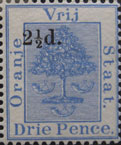
1896. Halfpenny stamps needed and the stock of 3d again utilised.
1896. The halfpenny surcharge in numerals was considered unsatisfactory, so one in words introduced.
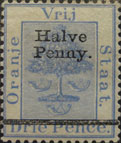
1897. More twopenny halfpenny stamps needed. The "d" was not used but one fraction on each pane of 60 shows the use of a Roman "1" and an antique "2".
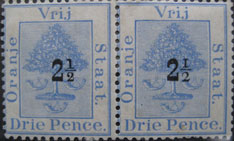
This was the last of the republican overprints.
Doubles, Trebles and Inverteds!
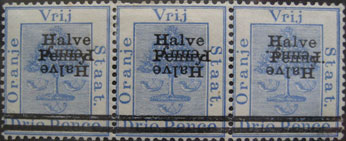
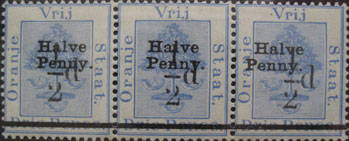
Spot the difference!
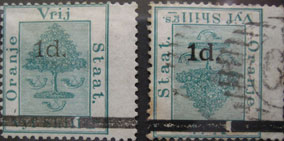
The Republican Telegraphs
A telegraph service was established in the Orange Free State about 1880 and the first issue of telegraph stamps appeared in September 1885. No definitive telegraph stamps were ever printed for use in the Free State and, instead, postage stamps and revenue stamps were given a variety of overprints.
Varieties
R.D.M. Official Franks
The Rijdende Dienst Macht (Mounted Police Force) franks were issued between 1896 and 1899. They bore no value and it is assumed that one frank was worth one penny, the equivalent of the postage for an internal half ounce letter. There were three issues, each in a slightly different design and each printed with a different type setting.

First Issue. Five types: 1. Damage to 4th ornament down on left; dots weak; T in Dienst faulty. 2. 6th ornament at top damaged; dots regular. 3. Bottom right ornament damaged; D of R.D.M. damaged; 6th and 13th dots faint. 4. Right hand ornaments dropped; 10th dot missing and 12th dot faint. 5. Break in left arm of V; 8th dot is large and 9th is an inverted comma.
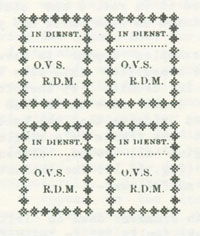
Second Issue. Four types printed in a block (2 x 2). 1. No stop after V; 2. Broken base to O; 3. Broken left serif to V; 4. No special features.
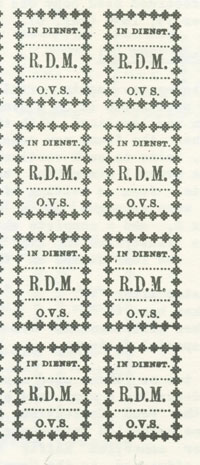
Third Issue. Block of 8 impressed three times to form a printing plate of 24 (6 x 4).
1. Spaces between 3rd and 4th dots in first line, and between 9th and 10th dots in second line. Faulty R and M; 2. No stop after V. Faulty D. 3. Faulty R in R.D.M. and O in O.V.S.; 4. Left serif of V faulty. 4th ornament of left faulty; 5. Spaces between 6th and 7th dots in first row, and 9th and 10th dots in second row; 6. Dot spaces as No. 5. 4th ornament at top faulty. stamp No. 14 in the setting of 24 has no stop after DIENST; 7. Spaces between 6th and 7th dots in first row, and 9th and 10th dots in second row. Fault R; 8. Spaces between 6th and 7th dots in first row, and 9th and 10th dots in second row. Dots 4 to 8 heavier in second row.
Home